Modulation of basolateral amygdala neuronal firing and afferent drive by dopamine receptor activation in vivo
- PMID: 10594083
- PMCID: PMC6784949
- DOI: 10.1523/JNEUROSCI.19-24-11027.1999
Modulation of basolateral amygdala neuronal firing and afferent drive by dopamine receptor activation in vivo
Abstract
The basolateral amygdala (BLA) is implicated in responding to affective stimuli. Dopamine (DA) is released in the BLA during numerous conditions; however, the neurophysiological effects of DA in the BLA have not been examined in depth. In this study, the effects of DA receptor manipulation on spontaneous and afferent-driven neuronal firing were examined using in vivo extracellular single-unit recordings in parallel with systemic and iontophoretic drug application, and stimulation of the substantia nigra/ventral tegmental area in the rat. The effects of DA receptor activation in the BLA were found to depend on the characteristics of the BLA neuron examined, causing an increase in the firing rate of putative interneurons and a decrease in the firing of identified projection neurons. Additionally, DA receptor activation attenuated short-latency spikes evoked by electrical stimulation of prefrontal cortical and mediodorsal thalamic inputs to the BLA while potentiating the responses evoked by electrical stimulation of sensory association cortex. DA receptor activation can thus attenuate BLA projection neuron firing via two mechanisms: (1) by a direct inhibition, and (2) by indirect actions mediated via activation of BLA interneurons. This is hypothesized to lead to a global filtration of weaker inputs. Moreover, DA potentiates sensory inputs and attenuates medial prefrontal cortex inputs to the BLA. Conditions in which DA is released in the BLA, such as during the presentation of an affective stimulus, will lead to a potentiation of the strongest sensory input and a dampening of cortical inhibition over the BLA, thus augmenting the response to affective sensory stimuli.
Figures
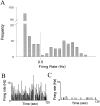
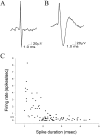
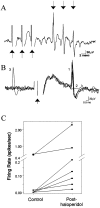


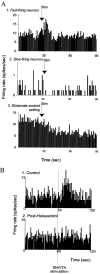
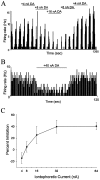

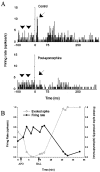
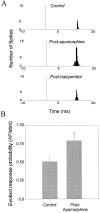
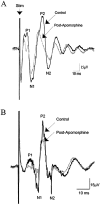
Similar articles
-
Dopamine attenuates prefrontal cortical suppression of sensory inputs to the basolateral amygdala of rats.J Neurosci. 2001 Jun 1;21(11):4090-103. doi: 10.1523/JNEUROSCI.21-11-04090.2001. J Neurosci. 2001. PMID: 11356897 Free PMC article.
-
Cellular mechanisms of infralimbic and prelimbic prefrontal cortical inhibition and dopaminergic modulation of basolateral amygdala neurons in vivo.J Neurosci. 2002 Jan 1;22(1):324-37. doi: 10.1523/JNEUROSCI.22-01-00324.2002. J Neurosci. 2002. PMID: 11756516 Free PMC article.
-
Dopaminergic regulation of inhibitory and excitatory transmission in the basolateral amygdala-prefrontal cortical pathway.J Neurosci. 2007 Feb 21;27(8):2045-57. doi: 10.1523/JNEUROSCI.5474-06.2007. J Neurosci. 2007. PMID: 17314300 Free PMC article.
-
Regulation of conditioned responses of basolateral amygdala neurons.Physiol Behav. 2002 Dec;77(4-5):489-93. doi: 10.1016/s0031-9384(02)00909-5. Physiol Behav. 2002. PMID: 12526988 Review.
-
Dopamine and N-methyl-D-aspartate receptor interactions in the neostriatum.Dev Neurosci. 1998;20(1):1-18. doi: 10.1159/000017294. Dev Neurosci. 1998. PMID: 9600386 Review.
Cited by
-
Targeting the brain: considerations in 332 consecutive patients treated by deep brain stimulation (DBS) for severe neurological diseases.Neurol Sci. 2012 Dec;33(6):1285-303. doi: 10.1007/s10072-012-0937-9. Epub 2012 Jan 24. Neurol Sci. 2012. PMID: 22271259
-
Similar neural activity during fear and disgust in the rat basolateral amygdala.PLoS One. 2011;6(12):e27797. doi: 10.1371/journal.pone.0027797. Epub 2011 Dec 14. PLoS One. 2011. PMID: 22194792 Free PMC article.
-
Region-specific contribution of the ventral tegmental area to heroin-induced conditioned immunomodulation.Brain Behav Immun. 2014 May;38:118-24. doi: 10.1016/j.bbi.2014.01.008. Epub 2014 Jan 24. Brain Behav Immun. 2014. PMID: 24462948 Free PMC article.
-
The extended amygdala and the dopamine system: another piece of the dopamine puzzle.J Neuropsychiatry Clin Neurosci. 2003 Summer;15(3):306-16. doi: 10.1176/jnp.15.3.306. J Neuropsychiatry Clin Neurosci. 2003. PMID: 12928506 Free PMC article. Review.
-
Cocaine and chronic stress exposure produce an additive increase in neuronal activity in the basolateral amygdala.Addict Biol. 2021 Jan;26(1):e12848. doi: 10.1111/adb.12848. Epub 2019 Nov 21. Addict Biol. 2021. PMID: 31750602 Free PMC article.
References
-
- Aggleton JP. The functional effects of amygdala lesions in humans: a comparison with findings from monkeys. In: Aggleton JP, editor. The amygdala: neurobiological aspects of emotions, memory, and mental dysfunction. Wiley-Liss; New York: 1992. pp. 485–503.
-
- Al Maskati HF, Zbrozyna AW. Stimulation in prefrontal cortex inhibits cardiovascular and motor components of the defense reaction in rats. J Auton Nerv Syst. 1989;28:117–126. - PubMed
-
- Arnold SA, Hyman BT, Van Hoesen GW, Damasio AR. Some cytoarchitectural abnormalities of the entorhinal cortex in schizophrenia. Arch Gen Psychiatry. 1991;48:625–632. - PubMed
-
- Asan E. Ultrastructural features of tyrosine-hydroxylase-immunoreactive afferents and their targets in the rat amygdala. Cell Tissue Res. 1997;288:449–469. - PubMed
-
- Bashore TR, Rebec GV, Groves PM. Alterations of spontaneous neuronal activity in the caudate-putamen, nucleus accumbens and amygdaloid complex of rats produced by d-amphetamine. Pharmacol Biochem Behav. 1978;8:467–474. - PubMed
Publication types
MeSH terms
Substances
Grants and funding
LinkOut - more resources
Full Text Sources
